
Modeling Fundamentals: Accounting for the Hours Clause
Oct 16, 2019
The hours clause is commonly found in European windstorm policies, but it is not commonly accounted for by catastrophe models. In this article, an hours clause is defined; the challenges of modeling the hours clause accurately are described; the impact of typical European windstorm policy hours clauses on occurrence losses is quantified, and the downscaling and uniform methods for quantification are compared.
What Is the Hours Clause?
The hours clause is an insurance policy that stipulates the insurer will cover all the financial losses accumulated in a defined number of hours. The number of hours in a typical clause depends on the peril. Tornado can be 24 hours, windstorm 72 hours, and flood 168 hours in the United States or 504 hours in Europe. Longer hours clauses tend to prevail in softer markets, as there is greater capacity to accept more risk.
In European windstorm policies the typical hours clause is 72 hours, but it could extend up to 168 hours. European windstorms tend to cluster, which means that the losses in a 72-hour window could stem from multiple windstorms. An infamous example is from December 1999 when two windstorms, Lothar and Martin, caused significant damage in a 36-hour window. To prevent a combined payout from multiple storms, insurers may add a second condition to the hours clause that states that losses can only come from a single storm. This is called an event-based hours clause.
The Challenges to Modeling the Hours Clause Accurately
There are two challenges to modeling the hours clause accurately. The first is the technical challenge of having adequate data storage and computational power to calculate the loss caused to each location in each hour in the model year for each event in the stochastic catalog. The second is the challenge of mimicking insurance practices. There is no standard approach in insurance for assigning a loss claim to a specific hour and policies can be handled inconsistently. For example, in the aftermath of Lothar and Martin, some reinsurers agreed to consider the two storms as separate events, contrary to the hours clause definition. Trying to model non-standardized, human behavior such as this is very difficult.
Insurers would like to understand the impact that hours clauses could have on annual occurrence losses. Some insurers will not have Europe-wide portfolios and would like to know the impact for specific countries or groups of countries. They may wish to know whether the 72 hours clause is truly adequate or whether there is an optimum hours clause for their portfolio. Lastly, insurers may wish to know how much information is sufficient to quantify the impact of the hours clause. For example, are CRESTA-level losses essential to accurately compute the impact on occurrence losses or would less detail suffice? The objective of this article is to answer these questions.
Quantifying the Impact of the Hours Clause through Modeling
To quantify the impact of the hours clause, AIR’s Industry Exposure Database for Europe was run through the AIR Extratropical Cyclone Model for Europe, which consists of a 10,000-year catalog of simulated ETCs that exhibit both temporal and spatial clustering. For each event in the model, a loss profile was created that showed the loss in each hour of each model year. Loss profiles are necessary to calculate the maximum accumulated loss in a given n-hour window where n is the duration of the hours clause. Two methods were used to do this: the downscaled method and the uniform method. As shown in the following section, the former produces more detailed loss profiles than the latter.
Downscaled versus Uniform Loss Profiles
The downscaled and uniform methods are best explained by showing how loss profiles over the UK are created for an event from the model’s catalog, which we’ll refer to as Event A. The map of the 22 countries belonging to the model domain and the UK CRESTAs is shown in Figure 1a.
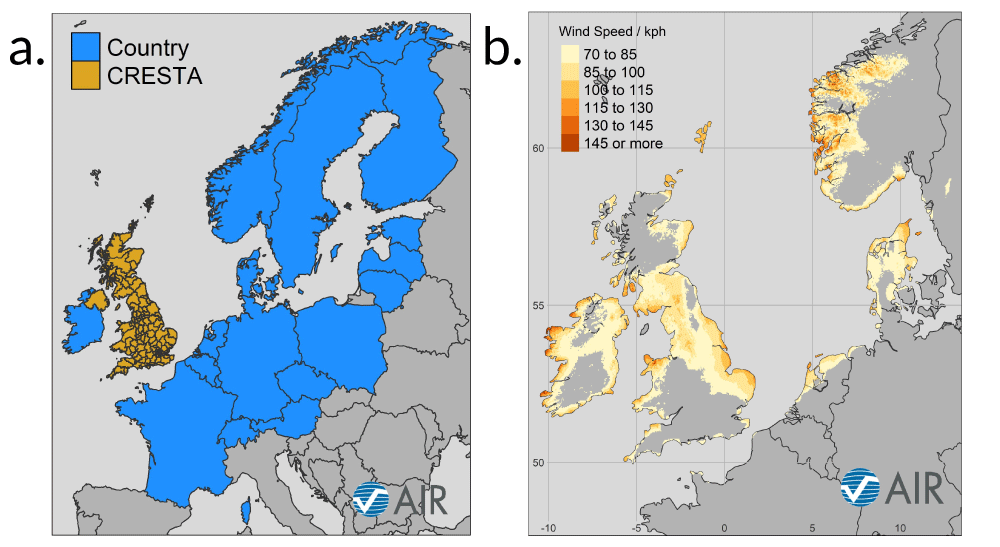
Figure 1b shows the wind gust footprint created by Event A. This event enters the UK on the first hour of December 26, known as Boxing Day in the UK, and spends 69 hours there, causing losses to 84 CRESTAs spanning the Outer Hebrides to Norwich. The loss to each UK CRESTA as a fraction of the UK’s overall loss is plotted against the longitude of each CRESTA centroid in Figure 2a. The far-left peak occurs in Northern Ireland, the middle peak at -3.8° longitude is in Llandudno, Wales, and the far-right peak is in Norwich, England.
The longitudinal range is divided into 69 bins, one for each hour spent by the storm in the UK. The loss associated with each longitude is then grouped into the 69 bins as shown in Figure 2b. The bins are mapped to the calendar hours 8641 to 8710 to give the downscaled profile shown in Figure 2c. A uniform profile is created by distributing the overall UK loss uniformly over the 69 hours spent by the storm in the UK.
The downscaled method appears to give a more realistic loss profile than the uniform method. For example, the downscaled profile does not give losses as the storm passes over the Irish Sea between Northern Ireland and Wales where there is no exposure, whereas the uniform profile does.
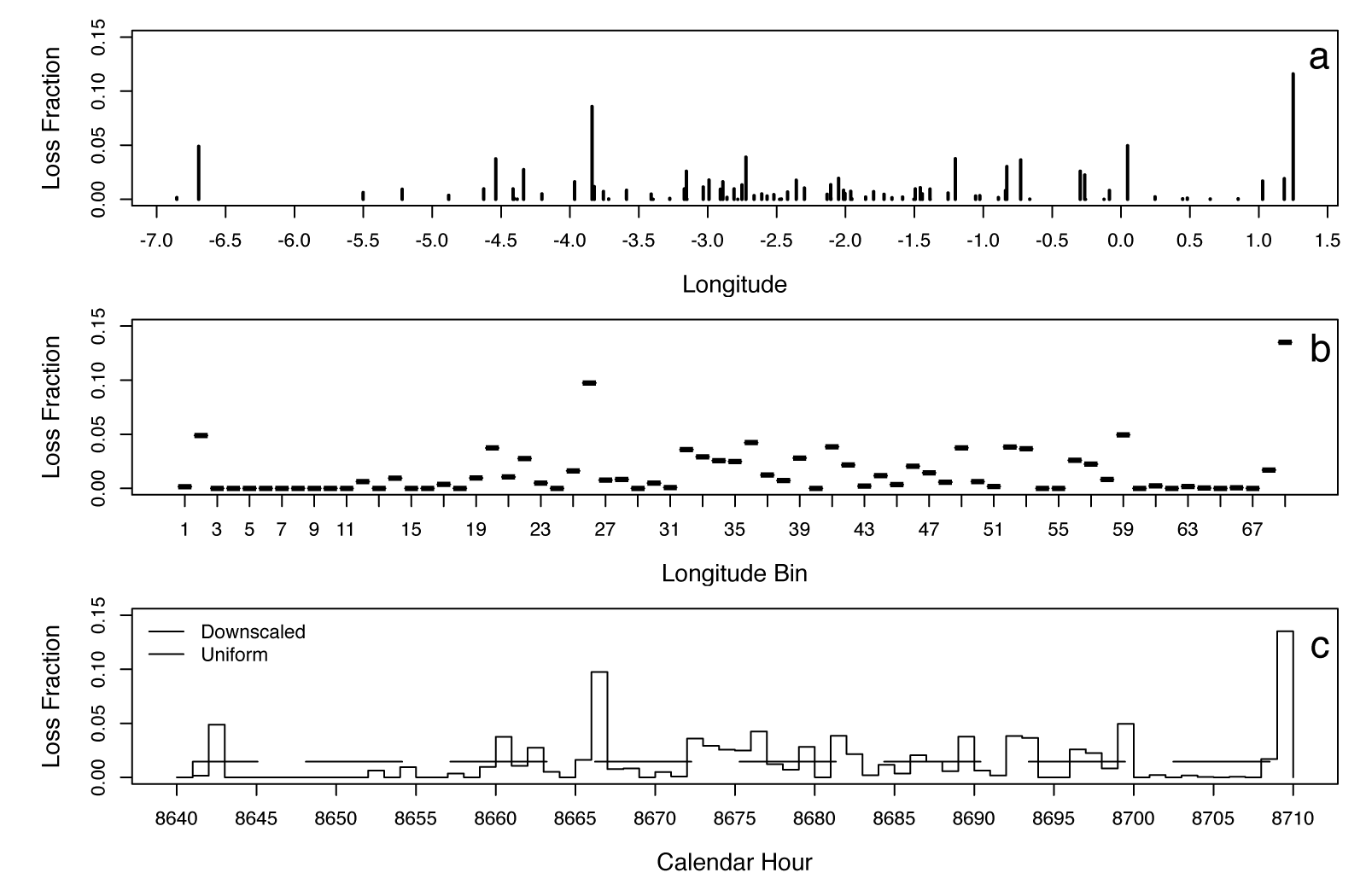
Performing Sensitivity Studies
The uniform profile requires less information about the event and is an easier approach to take. If the simpler uniform profile gives the same change in occurrence loss distribution as the downscaled profile, then the uniform profile should be used.
To perform this sensitivity study, the downscaled and uniform methods are used to create hourly loss profiles for each country for each event and each year in the 10,000-year catalog. An n-hour window is then scanned along each annual loss profile to determine the maximum loss accumulated in n hours. The process is carried out for 72, 96, 120, and 168 hours clauses on the entire model domain of the AIR Extratropical Cyclone Model for Europe. In a second sensitivity study, an n-hour window was scanned over loss profiles for each individual event to quantify the impact of the event-based hours clause.
Comparison of Downscaled and Uniform Methods when Measuring the Impact of the Hours Clause on Loss from Multiple Storms
Figure 3 shows that the 72 hours clause can lead to an increase of 2% to 13% in the European industry occurrence losses across the 0.5% to 5% exceedance probability range (10- to 50-year return periods). The increase is greatest in the 10%-50% range (2- to 10-year return periods). Impact is measured as the change in maximum annual loss due to the n-hours clause relative to the maximum annual loss without the hours clause. Therefore the greatest impact for a given return period will be observed when storms of similar loss occur within n hours of each other.
Low-loss storms are more likely to occur than high-loss storms and therefore clustering storms are more likely to be low-loss storms. High-loss storms are less likely to cluster with other high-loss storms because high-loss occurs when a strong storm hits a major city and it is very unlikely that two strong storms hit two major cities in Europe within 72 hours of each other. This explains why the hours clause has less of an impact at lower exceedance probabilities.
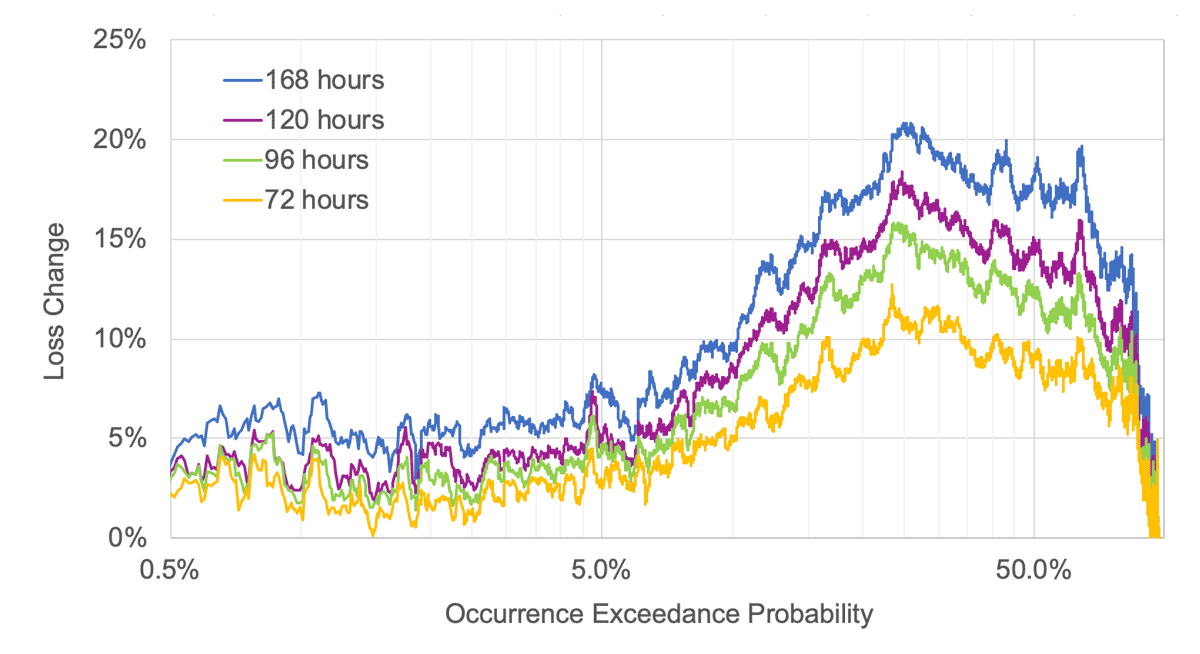
For longer hours clauses, the behavior is similar to that observed for the 72 hours clause, but the impact is exaggerated in the 10% to 50% range (2- to 10-year return period). Longer hours clauses lead to higher annual occurrences because more losses are accumulated within more hours. For high-loss storms, the peaks in the loss profile that contribute to most of the loss occur within a relatively short period of time, so lengthening the hours clause has less of an effect on the accumulated loss.
The results in Figure 3 were created using the downscaled profiles. Figure 4 shows that the uniform method gives as good an estimate as the downscaled method for Europe-wide losses and that the discrepancy reduces as the hours clause lengthens. The uniform method was also found to be adequate when investigating individual European countries—Austria, France, Germany, Switzerland, and the UK—and European regions—Benelux (Belgium, Netherlands, Luxembourg), Eastern Europe (Czech Republic, Hungary, Poland), and the Nordics (Denmark, Finland, Norway, Sweden).
This finding suggests that to quantify the impact of typical hours clauses on occurrence losses, loss profiles over individual countries can be assumed to be uniform. Knowing when the storm entered and left the country and the total loss to that country is sufficient. (This data is available to clients who license AIR’s ETC model for Europe.)
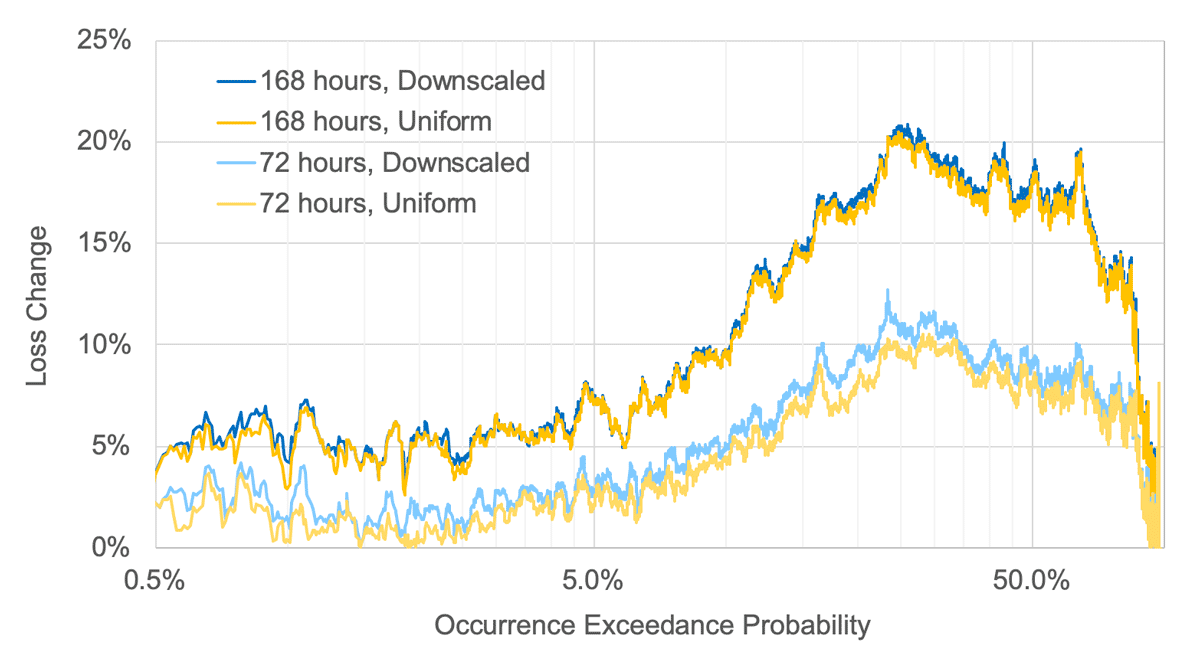
Event-Based Hours Clause
In an event-based hours clause, the loss is sourced from a single storm. Figure 5 shows that the typical time spent by an ETC in the model domain is between 30 and 60 hours. Just over 5% of the ETCs in the model’s stochastic catalog spend more than 72 hours in the model domain and the losses associated with these more enduring events is just over 7% of the total. For these events, the event-based hours clause will reduce the event loss by shortening the event.
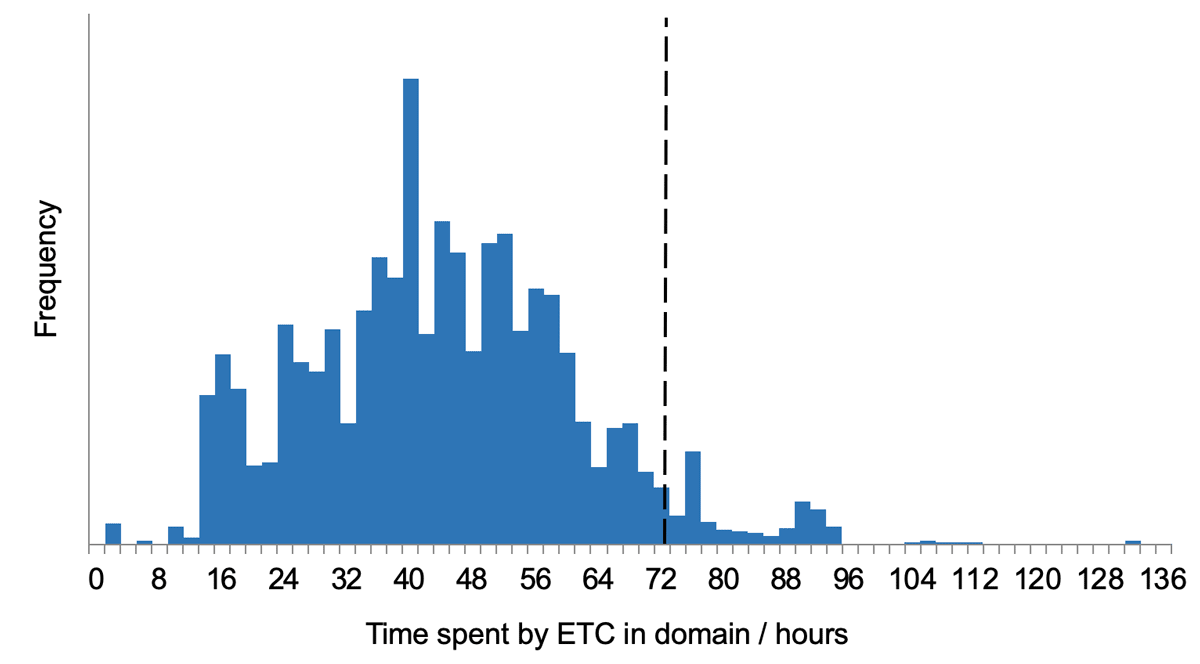
In Austria, Switzerland, Germany, and the Baltics, damage from ETCs lasts no more than 72 hours, therefore this hours clause has no impact on loss metrics. The remaining countries and regions experience ETCs lasting more than 72 hours, one of which is the UK where 9% of ETC losses are caused by storms lasting more than 72 hours. However, when the maximum accumulated 72-hour loss was calculated for every ETC, it was found that the hours clause had a negligible impact on the average annual loss, and the greatest impact it had on the annual aggregate and occurrence losses was -2.5%.
Conclusions
Typical hours clauses can increase the 2- to 10-year occurrence losses from European windstorms by as much as 10% to 20%, so it should be accounted for by insurers who write such policies. The uniform method is sufficient to quantify the impact and only requires the country-level loss plus the entry and exit times of a storm, all of which is readily available to model licensees. These findings can aid regulators, model developers, and insurers alike. It should not be too taxing to collect this information from a real windstorm event and regulators may wish to request it in future. Ultimately, insurers can use these findings to compare their claims experience with the models and better understand the impact that the hours clause has to their portfolios.
 Alastair Clarke, Ph.D.
Alastair Clarke, Ph.D.